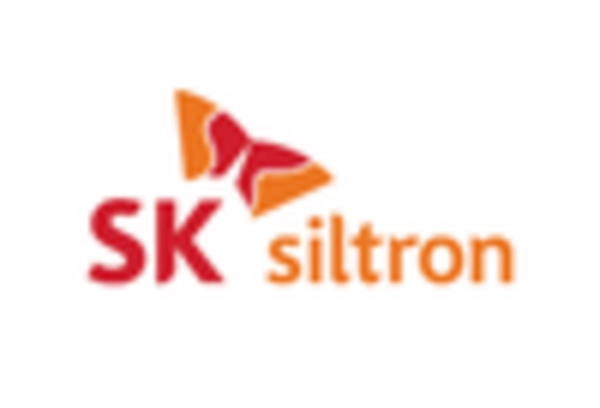Growth in Renewable Energy Sector
The silicon epi-wafer market is poised to benefit from the expanding renewable energy sector, particularly in solar energy applications. As the U.S. government continues to promote clean energy initiatives, the demand for photovoltaic cells is expected to rise. In 2025, the solar energy market is projected to grow by approximately 20%, which will likely increase the need for high-quality silicon epi-wafers used in solar panel manufacturing. This growth indicates a shift towards sustainable energy solutions, where silicon epi-wafers are integral to enhancing the efficiency and performance of solar cells. The silicon epi-wafer market is thus positioned to capitalize on this trend, as manufacturers focus on producing wafers that meet the stringent requirements of the renewable energy sector, ultimately contributing to a greener future.
Rising Demand for Consumer Electronics
The silicon epi-wafer market experiences a notable surge in demand driven by the increasing consumption of consumer electronics. As devices such as smartphones, tablets, and laptops become ubiquitous, the need for high-performance semiconductors intensifies. In 2025, the consumer electronics sector is projected to account for approximately 35% of the overall semiconductor market, thereby directly influencing the silicon epi-wafer market. This trend suggests that manufacturers are likely to invest in advanced silicon epi-wafer technologies to meet the growing performance and efficiency requirements of these devices. Furthermore, the proliferation of smart home technologies and IoT devices is expected to further bolster the demand for silicon epi-wafers, as these applications require sophisticated semiconductor solutions. Consequently, the silicon epi-wafer market is poised for substantial growth as it aligns with the evolving landscape of consumer electronics.
Expansion of Electric Vehicle Production
The transition towards electric vehicles (EVs) is significantly impacting the silicon epi-wafer market. As the automotive industry shifts focus to sustainable transportation solutions, the demand for advanced semiconductor components, including silicon epi-wafers, is expected to rise. In 2025, the EV market is anticipated to grow by over 25%, leading to an increased requirement for high-efficiency power electronics. Silicon epi-wafers play a crucial role in the manufacturing of power management systems and battery management systems essential for EVs. This shift not only enhances the performance of electric vehicles but also aligns with broader environmental goals. The silicon epi-wafer market is likely to benefit from this trend, as manufacturers adapt to the evolving needs of the automotive sector, thereby fostering innovation and technological advancements in semiconductor applications.
Increased Investment in Research and Development
The silicon epi-wafer market is experiencing a boost due to increased investment in research and development (R&D) activities. As the demand for advanced semiconductor technologies escalates, companies are allocating more resources to R&D to innovate and improve silicon epi-wafer production processes. In 2025, it is estimated that R&D spending in the semiconductor industry will rise by approximately 10%, reflecting a commitment to enhancing wafer quality and performance. This investment is likely to lead to breakthroughs in materials and manufacturing techniques, which could further drive the silicon epi-wafer market. By fostering innovation, companies can better address the evolving needs of various sectors, including telecommunications, automotive, and consumer electronics, thereby ensuring sustained growth in the silicon epi-wafer market.
Advancements in Semiconductor Manufacturing Techniques
The silicon epi-wafer market is significantly influenced by advancements in semiconductor manufacturing techniques. Innovations such as atomic layer deposition and molecular beam epitaxy are enhancing the quality and performance of silicon epi-wafers. These techniques allow for the production of wafers with superior electrical properties and reduced defects, which are crucial for high-performance applications. In 2025, the semiconductor manufacturing sector is expected to invest heavily in these advanced techniques, potentially increasing the efficiency of silicon epi-wafer production by up to 15%. This trend suggests that the silicon epi-wafer market will likely see a shift towards more sophisticated manufacturing processes, enabling manufacturers to meet the growing demands for high-quality semiconductors across various applications.














Leave a Comment